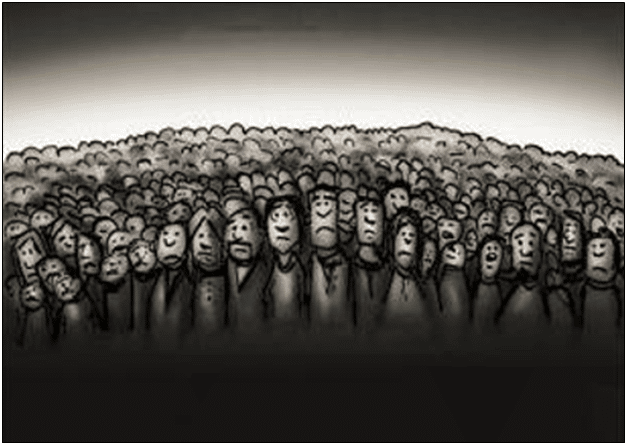
Nov. 20, 2025
Permission to republish original opeds and cartoons granted.
Inflation Continues Softening As Unemployment Creeped Up In September, BLS Data Shows
|

|
|
The Bureau of Labor Statistics finally got around to publishing the September unemployment report following the government shutdown, with the unemployment level once again increasing by 219,000 to 7.6 million, an increase of 1.85 million since January 2023. The unemployment rate rose to 4.4 percent, its highest level since November 2021. This is what usually happens as the economy unwinds from peak inflation that was seen in June 2022 at 9.1 percent under former President Joe Biden, hitting a low of 2.3 percent in April and back to about 3 percent in September. Next year, Federal Reserve economic projections from September have the inflation rate once again declining to 2.6 percent in 2026 and 2.1 percent in 2027. It has 2026 unemployment pegged at 4.4 percent on average, although the range has it getting as high as 4.6 percent. To go from a low in the unemployment rate to a high takes about 21 months, usually during or after a recession, correlating with the periods of disinflation. The record for increasing unemployment in modern history was 39 months, from 1989 to 1992, and we’re at 33 months now. The good news is labor markets could be close to hitting whatever bottom there is going to be from the inflation surge. Whether it ends in a recession or not, the reality is wherever that lands — it’s been years in the making.
|
$2,000 Checks Could Be Inflationary Just Like The 2020 And 2021 Covid Checks Were
|

|
|
Americans for Limited Government Executive Director Robert Romano: “Today, there is no deflationary threat, although we might be in a prolonged slowdown with unemployment up … [now 1.85 million] since Jan. 2023. This is certainly not the economic emergency seen in 2020, and if anything, we are still experiencing the disinflation from the last spending and borrowing binge. As it is, with the deficit clocking in at $1.77 trillion in 2025 and inflation still cooling… [w]e might be better off burning $1 trillion or so in a bonfire to reduce the money supply but my second choice is try to balance the budget, boost production to increase supplies and cut prices, and to boost wages.”
|
Inflation Continues Softening As Unemployment Creeped Up In September, BLS Data Shows

By Robert Romano
The Bureau of Labor Statistics finally got around to publishing the September unemployment report following the government shutdown, with the unemployment level once again increasing by 219,000 to 7.6 million, an increase of 1.85 million since January 2023. The unemployment rate rose to 4.4 percent, its highest level since November 2021.
This is what usually happens as the economy unwinds from peak inflation that was seen in June 2022 at 9.1 percent under former President Joe Biden, hitting a low of 2.3 percent in April and back to about 3 percent in September.
Next year, Federal Reserve economic projections from September have the inflation rate once again declining to 2.6 percent in 2026 and 2.1 percent in 2027. It has 2026 unemployment pegged at 4.4 percent on average, although the range has it getting as high as 4.6 percent.
To go from a low in the unemployment rate to a high takes about 21 months, usually during or after a recession, correlating with the periods of disinflation.
The record for increasing unemployment in modern history was 39 months, from 1989 to 1992, and we’re at 33 months now. Here are all the examples:
In May 1948, unemployment was at a low of 2.1 million and by October 1949 it increased 2.8 million and peaked at 4.9 million, or 7.9 percent, taking 17 months to get there.
In May 1953, unemployment’s low was at 1.59 million and by September 1954 it increased 2.3 million and peaked at 3.9 million, or 6.1 percent, over 16 months.
In March 1957, unemployment’s low was at 2.5 million and by July 1958 it increased 2.6 million and peaked at almost 5.1 million, or 7.5 percent, over 16 months.
In February 1960, unemployment’s low was at 3.3 million and by May 1961 it increased 1.7 million and peaked at 5 million, or 7.1 percent, over 15 months.
In December 1968, unemployment’s low was at 2.68 million and by December 1970 it increased 2.3 million and peaked at 5 million, or 6.1 percent, over 24 months.
In October 1973, unemployment’s low was at 4.1 million and by May 1975 it increased 4.3 million and peaked at 8.4 million, or 9.0 percent, over 19 months.
In May 1979, unemployment’s low was at 5.8 million and by July 1980 it increased 2.56 million and peaked at 8.36 million, or 7.8 percent, over 14 months.
In July 1981, unemployment’s low was at 7.86 million and by December 1982 it increased 4.1 million and peaked at 12 million, or 10.8 percent, over 17 months.
In March 1989, unemployment’s low was at 6.2 million and by June 1992 it increased 3.8 million and peaked at 10 million, or 7.8 percent, over 39 months — the longest period of increasing unemployment in the postwar period.
In April 2000, unemployment’s low was at 5.48 million and by June 2003 it increased 3.8 mllion and peaked at 9.26 million, or 6.3 percent, over 38 months.
In October 2006, unemployment’s low was at 6.27 million and by October 2009 it increased 9.1 million and peaked at 15.35 million, or 10.0 percent, over 36 months.
Finally, in September 2019 and February 2020 in the Covid recession, unemployment’s low was at 5.7 million and by April 2020 it increased 17.4 million and peaked at 23.08 million, or 14.8 percent, over 7 months.
Now, the unemployment low of January 2023 at 5.7 million has increased for 33 months to the current 7.6 million. Still not the longest but we’re getting close.
With the unemployment rate at 4.4 percent, if we were in a recession — every single one of these cycles has always ended with a recession — it might end up being the lowest unemployment rate of any recession since 1945, when unemployment peaked at 4.26 percent in May 1946, according to the National Bureau of Economic Research.
The point is that just because the unemployment rate is not above 5 percent doesn’t mean that the economy is not weakening. After 33 months of steadily rising unemployment, the economy President Trump inherited from former President Joe Biden is much weaker than thought.
One curiosity is that the employment level has been increasing steadily through the entire period of disinflation, from 158 million in June 2022 to 163.64 million in September. That might be the final shoe to drop, so it’s worth watching. Or maybe we’re getting a soft landing after all.
The good news is labor markets could be close to hitting whatever bottom there is going to be from the inflation surge. Whether it ends in a recession or not, the reality is wherever that lands — it’s been years in the making.
Robert Romano is the Executive Director of Americans for Limited Government Foundation.
To view online: https://dailytorch.com/2025/11/inflation-continue-softening-as-unemployment-creeped-up-in-september-bls-data-shows/

$2,000 Checks Could Be Inflationary Just Like The 2020 And 2021 Covid Checks Were
Nov. 19, 2025, Fairfax, Va.—Americans for Limited Government Executive Director Robert Romano today issued the following statement in response to President Donald Trump’s proposal for $2,000 checks for low and middle income households using tariff revenue:
“The $412.9 billion of checks that were sent out in 2020 on a bipartisan basis during Covid were designed to be inflationary, because they were occurring at a thankfully in hindsight brief moment of deflation. Oil had dropped to below-zero dollars per barrel as demand collapsed, global production was on its back amid the economic lockdowns and in the U.S., 25 million Americans temporarily lost their jobs in the blink of an eye. But for that bipartisan intervention by Congress and President Trump, including the relief sent to small businesses, and it is entirely possible the U.S. would have found itself in a depression that lasted much longer. Instead, it was a very steep but short-lived recession.
“That said, if the $412.9 billion of checks to households on a bipartisan basis in 2020 were questionable, then the $401.5 billion by then-President Biden and the Democratic Congress on a singularly partisan basis in 2021 was inexcusable, throwing fuel on the fire at a time when the economy was already fully recovering. A part of Biden’s American Rescue Plan, Democrats in Congress thought deflation was still a threat, and so those checks too were designed to be inflationary, and boy were they as demand came back rapidly while global supplies were still on their pandemic footing. By June 2021, inflation was up to 5.4 percent. By December 2021, inflation was up to 7 percent before peaking at 9.1 percent in June 2022. The checks and all of the other interventions over those two years played a substantial role in increasing the money supply by $6.3 trillion from February 2020 to March 2022, most of which occurred by January 2021.
“We’ll never know the counterfactual of what might have happened had there been no more checks in 2021. What’s important is the checks were sent out, and four years later, the American people are still paying for them.
“Today, there is no deflationary threat, although we might be in a prolonged slowdown with unemployment up … [now 1.85 million] since Jan. 2023. This is certainly not the economic emergency seen in 2020, and if anything, we are still experiencing the disinflation from the last spending and borrowing binge. As it is, with the deficit clocking in at $1.77 trillion in 2025 and inflation still cooling, we need another round of $2,000 checks like we need a hole in the head. They might not be intended to be inflationary but that wouldn’t change the likelihood that they will be inflationary. We might be better off burning $1 trillion or so in a bonfire to reduce the money supply but my second choice is try to balance the budget, boost production to increase supplies and cut prices, and to boost wages.”
To view online: https://getliberty.org/2025/11/2000-checks-could-be-inflationary-just-like-the-2020-and-2021-covid-checks-were/
